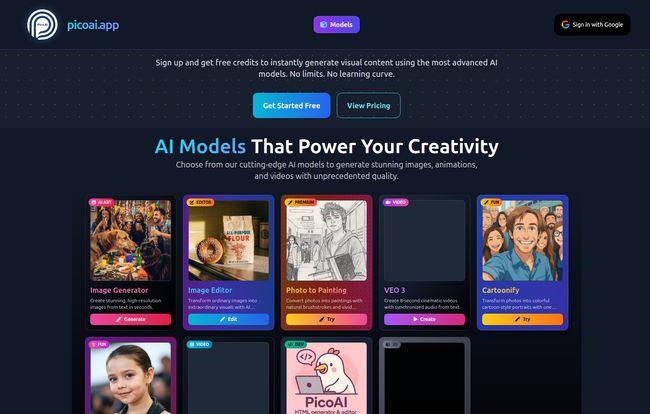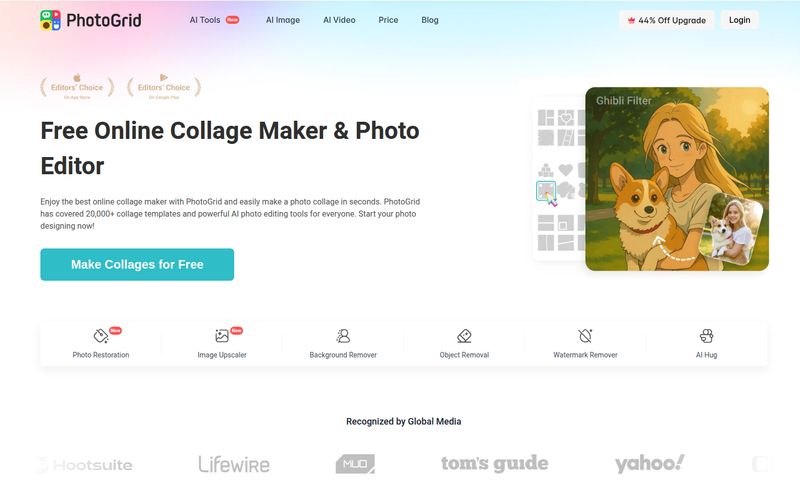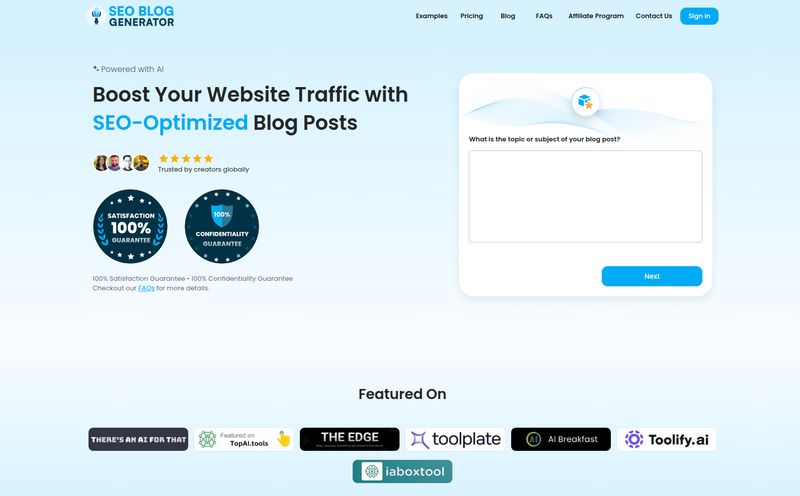The AI art scene has completely exploded over the last couple of years. One minute you're hearing about DALL-E, the next it's all Midjourney this and Stable Diffusion that. It’s enough to give any marketer or creative a serious case of FOMO. Keeping up with all the new tools, models, and Discord servers… it’s practically a full-time job. I’ve spent more late nights than I care to admit tinkering with prompts, trying to get the perfect six-fingered hand to look like, well, a normal hand.
So when another tool called PicoAI popped up on my radar, my first reaction was a bit of a sigh. Another one? But I gave it a look, and I’m glad I did. Because PicoAI isn’t trying to reinvent the wheel. It's doing something a bit different, and frankly, a bit smarter. It’s not a brand new foundational model; it’s a platform that brings together powerful AI models from established players like OpenAI and Replicate into one, easy-to-use interface. Think of it less like a new car engine and more like a beautifully designed dashboard that lets you drive a dozen different high-performance cars without needing a mechanic's license. So, let's pop the hood and see if it's all shiny chrome or just another leaky engine.
What Exactly is PicoAI Anyway?
At its core, PicoAI is an aggregator and a user-friendly playground for generative AI. Instead of you having to run complex code or navigate a dozen different websites, it puts a whole suite of creative tools in one spot. We're talking everything from standard text-to-image generation to more niche applications like turning your photo into a cartoon, creating stickers, or even generating simple animations from a static image. The landing page boasts over 12,500 users and a whole bunch of different models, which tells me it's gained some traction. It’s aiming to be a one-stop-shop for AI-powered visual content, and for a lot of people, that’s a very appealing proposition.

Visit PICO.AI
My First Impressions: The Good, The Bad, and The AI
Jumping in for the first time, a few things immediately stood out to me. The overall experience feels polished, but like any tool, it's a mixed bag of delightful surprises and a few head-scratchers.
The User Interface is Surprisingly Clean
I’m a sucker for a good dark mode, and PicoAI delivers. The layout is simple and visual. You’re greeted with a grid of tiles, each representing a different AI tool: “Cartoonify,” “Image to Video,” “Photo to Painting.” There’s no command-line nonsense, no confusing parameters to set right off the bat. You just click the tool that looks interesting and start creating. This is a huge win for beginners or for people who just want to get something made without a steep learning curve. It feels accessible, not intimidating.
A Buffet of AI Models
The variety is genuinely impressive. You’ve got your standard image generators, sure, but then there are specialized tools that are just plain fun. The “Baby Version” tool? Hilarious. The “Dragon Ball Z - Goku” character model? I mean, come on, that’s just speaking directly to my inner 90s kid. This is where PicoAI shines. It’s not just for creating photorealistic landscapes; it’s also for making memes, custom stickers, or a unique profile picture. By pulling models from different sources, it offers a breadth that a single-model platform like early Midjourney just couldn't match.
The "Free" Part of Freemium
You can start generating images on many of the models without paying a dime. This is the hook. You can test the waters, see if you like the output, and get a feel for the platform. But—and it's a big but—this is where we need to talk about the business model. The free generations are a great start, but to get high-quality downloads, you’re going to need to open your wallet.
Let's Talk About the Coin System: PicoAI Pricing Explained
Okay, so how do you pay? PicoAI uses a credit system with something they call “coins.” Instead of a flat monthly subscription like Adobe or Netflix, you buy packs of coins and then spend them on specific actions, mostly downloading your creations in high quality. Some of the more advanced models also require coins just to use them. It’s a classic pay-as-you-go model. Here's a quick breakdown of what some of the models might cost you, based on the info I could find.
| AI Model/Tool | Generations Included | Cost for HQ Download |
|---|---|---|
| AI Background Removal | 20 | 20 coins |
| Sticker Generator | 20 | 25 coins |
| Text2img - kandinsky 2 | 200 | 25 coins |
| Dragon Ball Z - Goku | 200 | 40 coins |
| ClarityVision Pro | 25 | 50 coins |
So, is this a good system? In my book, it depends entirely on who you are. If you’re a casual user who needs one great image for a blog post or a funny sticker once a month, this system is fantastic. You pay for what you use, and that's it. No recurring subscription fee for a tool you barely touch. However, if you’re a power user or an agency churning out dozens of images a day, this could get pricey, and a flat-rate subscription from a competitor might be more economical. The pricing. A bit confusing at first glance, honestly, and the website itself shows a “Subscribe to Unlock” button on some models, which suggests there might be multiple payment tiers. A little more clarity there would be nice.
Standout Features That Caught My Eye
Beyond the basics, a few tools really feel like they could be workflow game-changers for the right person.
More Than Just a Pretty Picture Generator
The AI-Powered Background Removal Tool is a gem. Yes, there are standalone tools for this, but having it integrated right where you're creating the image is just… smart. Create a product shot with AI, then immediately strip out the background to place it on your website. For social media managers and ecommerce folks, that’s a massive time-saver. It’s a utility, and sometimes utilities are more valuable than the flashy stuff.
From Static Image to Moving Picture
The Image-to-Video and animation tools are another huge differentiator. The ability to take a generated image and add subtle motion turns a simple graphic into a far more engaging piece of content. We’ve seen dedicated tools like Pika Labs and RunwayML make waves in this area, and it's a savvy move for PicoAI to incorporate similar features. It shows they understand that the future of content is dynamic.
Getting Specific with Niche Models
I mentioned the Goku model, but it’s part of a larger trend. Having these specialized models—whether for stickers, specific art styles, or pop culture characters—is what makes PicoAI feel less like a generic tool and more like a creative partner. You’re not just describing a style; you’re picking a pre-trained expert for the job. Its a clever approach that lowers the barrier for getting a very specific result.
Who is PicoAI Actually For?
After playing around with it, I think I have a good handle on who would get the most out of this platform.
- The Casual Creative & Hobbyist: Absolutely. This is your playground. The coin system means you only pay for the masterpieces you want to keep. It's perfect for making custom art for your D&D campaign, a unique social media avatar, or just for having fun.
- The Social Media Manager or Blogger: This is a strong contender. The ability to quickly generate blog headers, social media graphics, and ad creatives—and then remove the backgrounds—is incredibly efficient. It’s faster than briefing a designer for every little thing.
- The Professional AI Artist or Power User: Maybe not as your primary tool. If you live and breathe prompt engineering and need granular control over every seed, step, and sampler, you're probably still going to favor a local Stable Diffusion install or a paid Midjourney account. But, I could see it being a valuable tool for quick ideation or for specific tasks that its specialized models excel at.
Some Final Thoughts and Considerations
No tool is perfect. The main drawback is the potential cost. Those coins can disappear quickly if you’re a perfectionist who needs to download ten different versions of an image in high quality. And as I mentioned, the exact pricing structure feels a little opaque with hints of both coins and subscriptions. I’d love to see a clear, simple pricing page that lays it all out.
But that said, PicoAI successfully carves out its own niche in a very crowded market. It’s not trying to be the most powerful AI model on the planet. It’s trying to be the most accessible and versatile platform for creative AI, and it largely succeeds.
Frequently Asked Questions about PicoAI
Is PicoAI really free to use?
Yes and no. You can use many of the models to generate images for free to see what they look like. However, to download them in high quality or to use some of the premium models, you’ll need to purchase and spend “coins.”
What AI models does PicoAI use?
PicoAI acts as a user-friendly interface for a variety of powerful AI models from other companies, most notably Replicate and OpenAI. This allows them to offer a diverse range of styles and functionalities.
Can I use the images I create commercially?
This is the million-dollar question for any AI tool. The answer almost always depends on the specific terms of service of the platform and the underlying models it uses. My advice is always to read PicoAI's terms and conditions carefully before using generated assets for commercial projects.
How does PicoAI compare to Midjourney or DALL-E 3?
Think of it this way: Midjourney and DALL-E are like specialized, high-end restaurants with a world-class chef. PicoAI is more like a massive, high-quality food hall. It brings dozens of different amazing food stalls (the AI models) under one roof, making it easier to try a bit of everything. It's often more straightforward for beginners and offers more utility-based tools like background removal.
What is the “coin” system?
It's a credit-based, pay-as-you-go system. You buy a package of coins, and then you spend those coins to perform certain actions, like downloading a high-resolution version of an image you created.
The Verdict: Should You Add PicoAI to Your Toolbox?
So, what’s the final word? I think for a huge number of people, the answer is a resounding yes. If you’ve felt a little overwhelmed by the AI art world, or if you’re a marketer who needs good-looking visuals without the fuss, PicoAI is a fantastic entry point. It demystifies the process and puts an incredible amount of creative power just a few clicks away.
While power users might stick to their more complex setups, PicoAI has firmly earned a spot in my digital toolbox for its speed, versatility, and sheer convenience. It's a reminder that the best tool isn't always the one with the most knobs and dials; sometimes, it's the one that just lets you create. Go give the free models a spin. You've got nothing to lose and a whole new creative world to gain.
Reference and Sources
- PicoAI Official Website
- OpenAI - One of the foundational model providers.
- Replicate - A platform for running and sharing machine learning models, used by PicoAI.
- The Verge's Guide to AI Image Generators - For a broader look at the current landscape.



